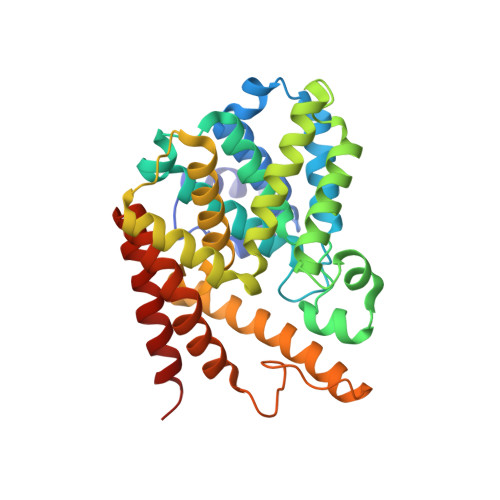Synthesis, structural analysis, and biological evaluation of thioxoquinazoline derivatives as phosphodiesterase 7 inhibitors
Castano, T., Wang, H., Campillo, N.E., Ballester, S., Gonzalez-Garcia, C., Hernandez, J., Perez, C., Cuenca, J., Perez-Castillo, A., Martinez, A., Huertas, O., Gelpi, J.L., Luque, F.J., Ke, H., Gil, C.(2009) ChemMedChem 4: 866-876
- PubMed: 19350606
- DOI: https://doi.org/10.1002/cmdc.200900043
- Primary Citation of Related Structures:
3G3N - PubMed Abstract:
PDE7 inhibitors regulate pro-inflammatory and immune T-cell functions, and are a potentially novel class of drugs especially useful in the treatment of a wide variety of immune and inflammatory disorders. Starting from our lead family of thioxoquinazolines, we designed, synthesized, and characterized a novel series of thioxoquinazoline derivatives. Many of these compounds showed inhibitory potencies at sub-micromolar levels against the catalytic domain of PDE7A1 and at the micromolar level against PDE4D2. Cell-based studies showed that these compounds not only increased intracellular cAMP levels, but also had interesting anti-inflammatory properties within a therapeutic window. The in silico data predict that these compounds are capable of the crossing the blood-brain barrier. The X-ray crystal structure of the PDE7A1 catalytic domain in complex with compound 15 at a resolution of 2.4 A demonstrated that hydrophobic interactions at the active site pocket are a key feature. This structure, together with molecular modeling, provides insight into the selectivity of the PDE inhibitors and a template for the discovery of new PDE7 or PDE7/PDE4 dual inhibitors.
Organizational Affiliation:
Instituto de Química Médica (CSIC), Juan de la Cierva 3, 28006 Madrid, Spain.

















